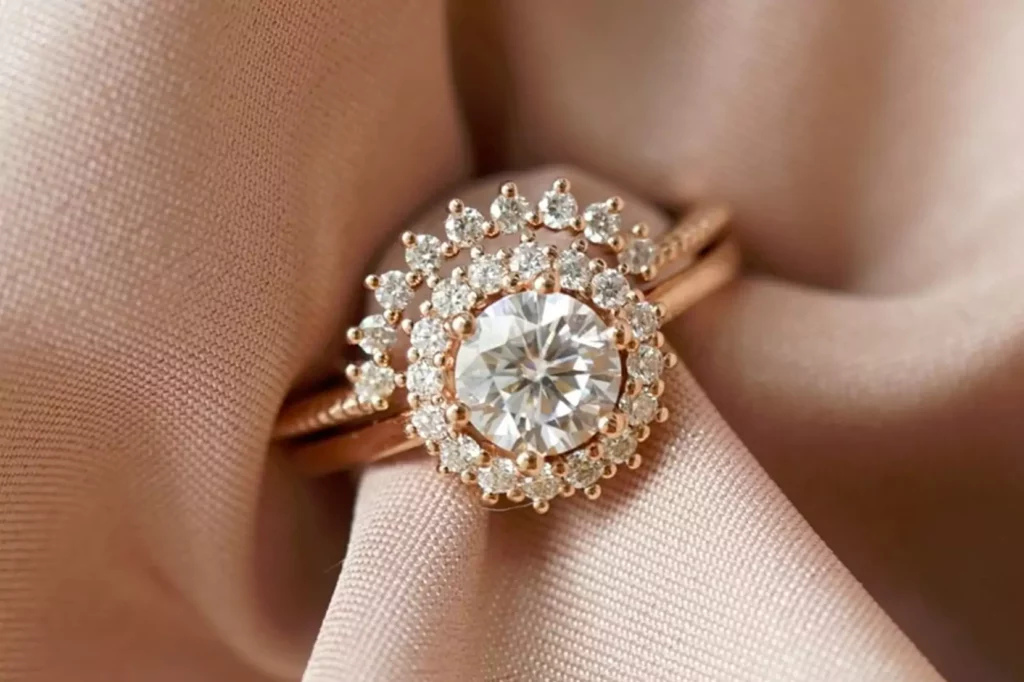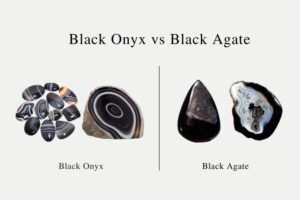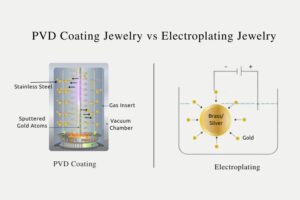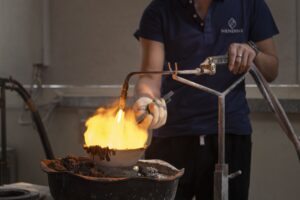Most people have heard of diamonds and their allure. However, little is known about moissanite. In this piece, we’ll compare the well-known diamond with the lesser-known moissanite as well as examine their differences.
When it comes to valuable minerals, there are numerous varieties. Occasionally, two or more minerals exhibit the same characteristics, making it possible for unsophisticated purchasers to be duped into purchasing a “fake.” Having said that, the word “fake” is a relative one. Unless it is intended to be a fake, the fact that one mineral that is regarded as inferior closely resembles another of greater quality does not make it a fake.
In this article, I’d be establishing the connection between diamonds and moissanite, two minerals that are very similar in a number of ways. Comparisons based on specific criteria will also be made to see which emerges as the best buy. So without further ado, let’s get down to business.
What is a diamond?
Diamonds are rare, naturally occurring minerals composed entirely of carbon. They are the most popular among all gemstones and are also known to be the hardest naturally occurring substance. A diamond is usually clear and colorless (there are naturally colored ones; in fact, diamonds come in every color). These hues result from impurities or structural flaws in their chemical makeup, and they have several characteristics that set them apart from other gemstones. Diamonds’ high price is a result of these distinctive qualities.
The characteristics of a diamond include the following:
- High strength
Diamonds have a very high degree of strength. Strength is different from hardness in that strength measures how much stress can be applied to an element before it deforms permanently or fractures. In contrast, hardness measures a material’s resistance to surface deformation.
- High hardness
Diamond, which is ranked 10th overall on the Mohs scale, is the hardest naturally occurring substance. Materials are ranked on the Mohs scale based on how hard they are compared. One interesting fact about diamonds is that, because of their extreme hardness, the only other mineral that can scratch a diamond is another diamond.
- High electrical resistivity
The manner in which the atoms of diamonds bond together ensures that there are no free electrons for the conduction of electricity, thus making carbon an insulator.
- Highly resistant to chemical corrosion
Diamond is chemically inert to most acids and bases, thus greatly reducing the risk of corrosion.
- High thermal conductivity
Diamond has the highest thermal conductivity of any known material at room temperature. This is quite surprising because most materials have a direct relationship between electrical and thermal conductivity, and diamonds are known to be excellent insulators or poor electrical conductors. To put the thermal conductivity of diamonds into perspective, diamonds have a thermal conductivity five times greater than silver, the metal with the highest thermal conductivity. Ludicrous, right?
- High refractive index
This is a measure of the reflectivity of a substance. The reflectivity of a material determines its brilliance or luster. Diamonds, with a refractive index of 2.42, complete the list of the top 3 most reflective substances on earth.
After learning what a diamond is and examining some of its distinctive qualities, let’s examine diamonds from additional perspectives, including their composition and sources.
Compositions
Another unique aspect of diamonds is that they are the only gemstones made of a single element. All other gems are made of two or more elements. However, diamonds are composed of 99.5% carbon. The other 0.05% represents one or more trace elements, which do not usually have any chemical significance in the gemstone. However, in the case of colored diamonds, the presence of elements other than carbon and trace elements is responsible for coloration. For example, nitrogen is present in yellow diamonds, while boron is present in blue diamonds.
Where Are Diamonds From?
There are two types of diamond sources: natural diamonds and artificial or lab-made diamonds.
Natural diamonds
Natural diamonds are diamonds that exist naturally. That is, they do not owe their existence to the direct or indirect actions of man. Natural diamonds are formed when carbon atoms crystallize over a very long period (about 1 to 3 billion years) at depths of about 100 miles beneath the earth’s mantle and under extreme heat and pressure conditions.
Once a diamond is formed in these subterranean conditions, it is transported to the earth’s surface by molten rock, where it is mined, purified, and used for jewelry making or other industrial uses.
Artificial diamonds/Lab-grown diamonds
Artificial diamonds/lab-grown diamonds, or synthetic diamonds, are created from a synthetic substance that shares the same chemical makeup and fundamental crystal structure as a diamond. Lab-made diamonds are identical to natural diamonds and share the same properties.
The only difference is that they are grown in a laboratory. While it takes billions of years to create a natural diamond, artificial diamonds are formed in a lab within a matter of days (between 3 – 5 days). This implies that compared to synthetic diamonds, natural diamonds are rarer.
Due to technological advances, synthetic diamonds are becoming more common, which is why natural diamonds are more expensive than their synthetic counterparts.
What is Moissanite?
Moissanite, which is also known by its trade name “carborundum,” is a naturally occurring compound of silicon carbide and its various crystalline polymorphs. It is very rare and can’t be found in quantities large enough to be made into proper gemstones.
As a result, lab-grown moissanite is typically utilized in jewelry. It comes in a variety of colors. Blue, emerald green, crimson, dark gray, champagne, bright yellow, purple and even black are the various colors offered on the market.
Source: Pinterest
Moissanite is a diamond simulant. In other words, moissanite duplicates diamonds’ aesthetic qualities or appearance. Moissanite is a far less expensive option than diamonds. This is the outcome of supply and demand in the fashion business, not a direct reflection of its quality.
Compositions
Unlike diamond, which is composed of a single element, moissanite is a compound. That is, it is made of two or more elements (carbon and silicon).
Moissanite is otherwise referred to as silicon carbide (SiC) in scientific terms. It consists of one silicon atom and four carbon atoms.
Where Are Moissanites From?
Where does moissanite come from? is the crucial question here.
The genesis of moissanites is space. Dr. Henri Moissan, a French scientist, found the first moissanite samples in a meteorite crater in Arizona. Because moissanites and diamonds are so similar, the discoverer initially believed he had found diamonds. However, it was eventually discovered that these new crystals were made of silicon carbide, not pure carbon, as in diamonds.
Though we surely adore the thought of donning jewelry from outer space, the reality is that since natural moissanites are so uncommon, all the moissanite jewelry you own is actually produced from lab-grown moissanites.
Moissanite vs. Diamond
In this section, diamonds and moissanite will be compared from different standpoints in order to help you decide which of the two is just right for you.
- Price
In terms of price, both categories of diamonds (synthetic and natural) are more expensive than moissanites. This is what makes moissanite a great alternative to diamonds.
- Durability
Both minerals are highly durable. However, diamonds slightly edge out moissanites when it comes to durability. On the Mohs scale of hardness, diamonds, the hardest naturally occurring substances, have a score of 10 out of a possible 10, whereas moissanites have a score of 9.25. Because of their durability and resistance to wear and scratching, these materials are ideal for crafting jewelry that may be worn every day.
- Color
Most moissanite jewelry is usually labeled as colorless, although it could have a greenish or yellowish tint depending on lighting. Moissanite is available in just about any color you may imagine. They go through a special process in order to add color to them.
Just like moissanites, diamonds may be either colorless or colored. Colorless diamonds have a dazzling white appearance.
Tips to Tell Moissanite vs Diamond
Can the average person tell the difference between moissanite and diamond?
Even though they look the same at first glance, there are several ways through which you can tell a diamond from a moissanite if you come across them.
Here are a number of things to look out for:
- Light dispersion or “fire”
This is an easily visualized measurement of how light is dispersed into its constituent colors when it enters either gemstone. It is observable that light is better split into brighter, colorful components in moissanites than in diamonds. Thus, it can be said that moissanite has more fire than a diamond.
- Price
If there ever was an answer to the question, “Why is moissanite better than diamond?” The answer lies in the pricing. Moissanites are way cheaper than diamonds while having similar aesthetics. A moissanite of the same size, shape, cut, and clarity as a diamond of the same proportions may hold just about 10 to 15% of the diamond’s worth. Therefore, if the price of a piece of jewelry that looks like a diamond sounds too good to be true, it most likely is a diamond look alike. However, a “diamond” piece of jewelry’s price by itself cannot guarantee its authenticity because you may purchase a fake for the same price as a real diamond.
Continue reading to learn more methods for determining a moissanite or diamond piece’s authenticity.
- Diamond tester or moissanite tester
These are devices that can accurately determine the authenticity of a gem through the examination of its physical properties. However, a diamond tester will only tell you whether or not a gem labeled as a diamond is a diamond. The same goes for moissanite testers.
- Moissanite has more clarity than diamonds
Nowadays, the majority of moissanite sold is created in laboratories under closely regulated conditions that minimize internal flaws, which is why this stone typically has better clarity than most diamonds.
- Brilliance
Because moissanites have a higher refractive index than diamonds. They are able to bend light better.
A polished spherical moissanite will appear to have doubled facets if you gaze through the top or side of the stone. You shouldn’t be able to see such an effect with diamonds. The light-bending ability of an object determines its brilliance, and in this regard, moissanites come out on top.
Conclusion
Due to their historical significance, distinctive qualities, rarity, great demand, and low supply, diamonds are valued higher than all other gemstones.
That said, there are a few substitutes for a diamond piece, and nothing does it quite like moissanites. Not only do they have more brilliance and fire than diamonds, but they are also clearer and almost as hard as diamonds. It’s quite the diamond substitute, right?




